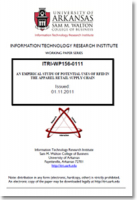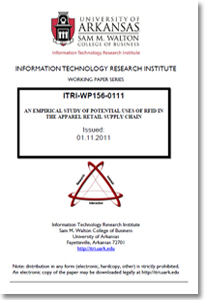An Empirical Study of Potential Uses of RFID in the Apparel Retail Supply Chain
The findings of this exploratory study show that the potential benefits of item-level RFID in the apparel supply chain reach beyond the retailer to include apparel production and distribution.
Phase I of an empirical study of potential uses of radio frequency identification (RFID) in the apparel supply chain was conducted in the fall of 2010.
This Phase of the research was designed to identify potential use cases for the use of RFID in an apparel supply chain and was funded by GS1 US and the American Apparel and Footwear Association (AAFA).
The three-phase Supplier ROI study is commonly referred to as the Many-to-Many study. Phase II will involve the measurement of ROI for select use cases identified in Phase I. Phase III will study the effect of RFID on multiple suppliers simultaneously through an experiment.
The use cases were solicited from a wide range of companies, in several different countries, in many different types of facilities, and thus reveal where the industry collectively believes the greatest RFID benefits reside. Over a period of several months, we collected more than 60 use cases.
The findings of Phase I show that the potential benefits of item-level RFID in the apparel supply chain reach beyond the retailer and include apparel manufacturers. To begin, improved backroom-to-shelf replenishment and greater perpetual inventory (PI) accuracy, which result from RFID are shown to offer manufacturers the opportunity to increase top-line sales, due to higher product availability at the retail shelf.
Not surprisingly, we found that RFID offers manufacturers the opportunity to improve inbound and outbound operations at all echelons. By implementing RFID, the supply chain can undertake scanning as each carton crosses the dock door at any location, which should substantially decrease the number of touches per carton. Because labor accounts for the largest portion of variable costs in an apparel distribution network, RFID is quite promising in terms of labor cost reduction.
Item-level RFID tagging also offers apparel manufacturers the ability to audit the contents of each carton being shipped to its retail customers through an automated audit process, such that the apparel manufacturer can find errors in the redistribution process prior to those errors being found by the retail customer. This step ultimately reduces the deductions or chargebacks from the manufacturer’s customers.
In addition, RFID can reduce inventory-related costs throughout the apparel supply chain by reducing ordering costs in the form of reduced shipping and receiving costs and fewer errors associated with shipping and receiving. As the ordering costs decline due to RFID business processes, the optimal time between orders shortens, and the optimal frequency of orders increases. Thus, cycle stock is reduced. Furthermore, RFID improves PI accuracy, which means that it reduces stock safety levels throughout the supply chain.
What’s Related

Favorites





